This morning it was bitter cold, overcast, and windy, with on and off rain. We debated going into Rome, kind of afraid to leave Kosmos in the heavy wind. We decided we were being paranoid, though, and went.
The first thing on today’s list of sites to see was the Pantheon. We exited the Colosseum Metro station to see our connecting bus leaving. Darn. It was really cold and had started raining again, so we took shelter in a nearby café for some hot food and beverages to warm us up. After lunch, we caught a bus that dropped us a few blocks away from the Pantheon. Fortunately, we didn’t have to stand in the rain long.
On the walk over, we passed a statue of an obelisk strapped to the back of an elephant, quite similar to the one that we had seen in Catania. We are pretty sure that the obelisk in Catania isn’t a real Egyptian artifact. It just didn’t have that real Egyptian look to it. However, in passing by this statue, it was immediately evident to us that the obelisk had been pilfered from Thebes (Luxor), Egypt. It is made of the marble that is dominant in most of the temples in Thebes we saw, and it is inscribed with hieroglyphics, looking incredibly similar to the obelisks we had seen in Thebes. We checked Lonely Planet, and, sure enough, it is a real Egyptian obelisk dating from the 6th century BC. The statue was designed by famed sculptor Bernini.
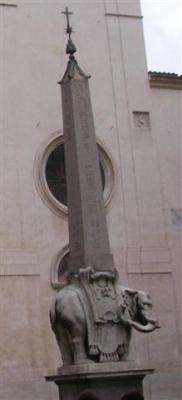
We can’t remember if we mentioned this when we were in Egypt, so this may be repeat info. There used to be quite a few obelisks in Egypt, but only a handful remain today. The rest were taken by other countries, particularly by the Roman Empire. Sadly, there are more ancient Egyptian obelisks in Rome than there are in Egypt. It was kind of weird to think that we have been to this precious object’s hometown.
Lonely Planet also mentioned that the church behind the statue is a Gothic treasure trove, but it looked to be closed. It didn’t look all that exciting from the exterior. From the elephant/obelisk statue, we could see the back of the Pantheon, which simply looked like a plain round building made of brick, more like a water cistern than a temple. We walked around to the front, where there is a classical façade in front of the dome, a triangular marble pediment supported by really fat marble pillars. You can see the dome sticking up behind the façade.
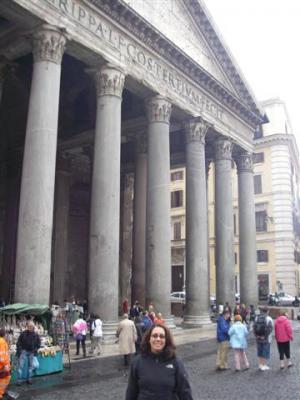
The Pantheon was built in 27 BC as a pagan temple (“pan” means all, “theon” means gods). It was rebuilt in 125 AD after a fire destroyed the original one. The dome is a perfect semi-sphere (the diameter and height are each 43.3 meters), and is the largest masonry vault ever built. It is considered the Roman’s most important architectural achievement. The light comes through a 9 meter circular opening in the top of the dome, and there is drainage in the floor for when it rains. In 608, it was turned into a church. The Church has left the building mostly intact, so it looks much the same now as it originally did when it was a pagan temple, but they have stripped away most of the exterior marble that covered the brick of the dome and the bronze that coated the ceiling (this is actually the source of the bronze for the weird big sculpture on the high altar of St. Peter’s Basilica). It is the best preserved ancient building in Rome. Assorted saints and martyrs, the famous artist Raphael, and a couple of kings are all buried here.
We walked in and were surprised to see that it is a single round room with a gigantic dome. We suppose we were expecting a bigger complex with a dome in the middle somewhere, like all the other churches we have been to. The walls and floors beneath the dome are mostly colored marble in geometric designs. There is a consistent alternating pattern all the way around, with alcoves several feet wide protruding from the wall and in between each of the alcoves are two decorative columns. The alcoves each hold assorted statues. We assume back when it was a pagan temple that each alcove held a statue of a different god, and that there were you went in and worshipped before whichever god you were calling upon on that day. The walls behind the columns are more eclectic, some with statues inset into the wall, some with paintings, some with tombs, or some combinations of the three. Back in ancient times, there were probably more gods displayed behind the columns. There is one especially large alcove, which was originally used for worship of the reigning king, and is now the main sanctuary of the church.
Of course, the focal point is the amazing dome. It isn’t like anything we have ever seen before. We have never before noticed that domes aren’t really semi-spheres, but here it is strikingly evident that the proportions are absolutely perfect. It is enormous, too big to get into a photo. There is a perfect pattern of squares in the ceiling that goes all the way to the hole at the center. It is like being in a planetarium. In the second photo, you can see part of the roof. Interestingly enough, despite the rain, the floor was dry. We couldn’t see the drainage holes anywhere, but they were obviously working.
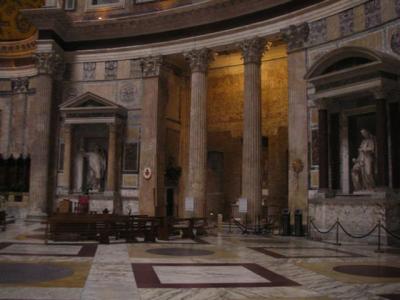
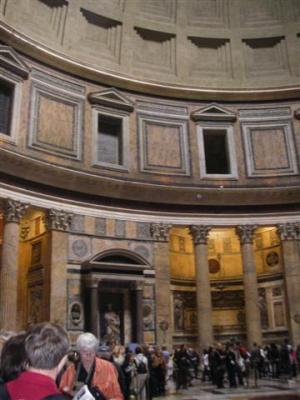
In front of the Pantheon is a piazza, and in the middle of it is a fountain. In the center of the fountain is a sculpture with fish and other interesting looking creatures spitting water into the little pool, and topped with a genuine ancient Egyptian obelisk. This one also looks like it came straight from Thebes. There is a cross mounted to the peak of the obelisk.
The next place we wanted to go was Castel St. Angelo. It was within walking distance, but it was a dreary day, so we headed back the way we came to try to find a bus. We took different roads, though, just enjoying the architecture, various monuments, and getting a feel for the city. The looks of various streets and buildings vary, one street will feel like Palermo, another like Siracusa, but all the various eras of architecture and urban design have become familiar to us now that we have spent so much time in Italy. The building pictured was one of the more unique we saw. It is one of several matching buildings that form an oval around a piazza. They were built in the 13th century and were part of the business district. Who knows what they are used for nowadays.
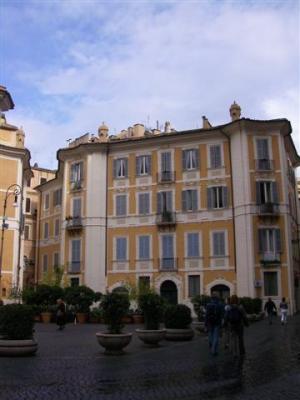
We must have taken all the wrong streets, because by the time we found a bus stop we were at the Vittoriano, which is almost as long of a walk as the Castel, but in the opposite direction. Oh well. It is Rome’s most visible landmark, and was built to commemorate Vittorio Emanuele II and Italian unification.

There is a museum inside documenting the history of the Italian Unification movement. We weren’t interested in the museum, but we did want to get a closer look at the building and statues. Walking up the first flight of stairs puts you on the level where the lady outlined in yellow is, which is kind of the lower middle of what you can see of the building in the picture. This level houses the Tomb of the Unknown Soldier, with the requisite accompanying eternal flame and protective armed soldiers. If you look carefully, you can see just how big and detailed the friezes on the wall are. Each woman represents a city in Italy.
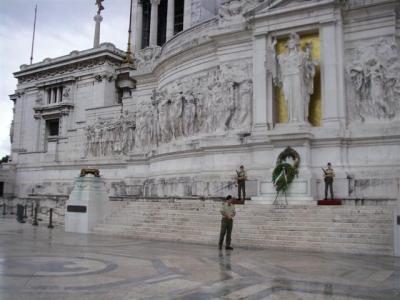
The next level up offered a nice view of the city in front of us. We got a closer look at more of the artwork. This statue of Vittorio Emanuele II is 12 meters tall by 10 meters wide and weighs 50 tons, double the weight of our boat fully loaded with water and fuel.
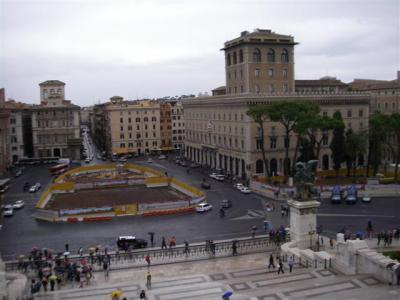

By now it was really starting to rain hard, so we went up to the top floor, where all the pillars are, in search of shelter. The stairs put us at the southwest corner, and you could only walk down the side of the building. This side has a great view of the Colosseum (to the right) and the Imperial Forums (starting on the left and extending almost down to the Colosseum, paralleling the street).
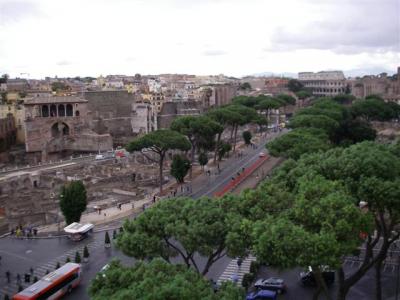
It turns out there is a café at the back of the building. We went in, but there were no tables. We accidentally wandered into the backdoor of the museum. While no one kicked us out, we decided not to stay and ventured back out in the rain to find a café where we could sit down. We found one across the street.
To be continued”¦
